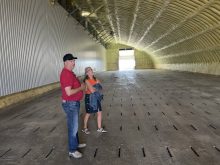The number of empty plastic milk jugs and cardboard milk cartons diverted from Alberta landfills would stretch from Edmonton to Saskatoon if stacked uncrushed on semi trailers.
Since the Alberta milk jug recycling program began in 1999, the equivalent of more than 194 million four-litre milk jugs and 30 million two-litre poly coated milk cartons have been recycled, which is the equivalent of 45,000 semi trailers parked end to end for 540 kilometres.![]()
Read Also

New coal mine proposal met with old concerns
A smaller version of the previously rejected Grassy Mountain coal mine project in Crowsnest Pass is back on the table, and the Livingstone Landowners Group continues to voice concerns about the environmental risks.
“That’s a huge impact on diversion from landfill,” said Roberta Windrum of the Alberta Dairy Council’s recycling program.
The program began as a way to keep plastic milk jugs out of provincial and municipal landfill sites. Most of the milk jugs were tossed into regular household garbage and buried along with other waste at the dump.
Provincial municipalities challenged the dairy industry to come up with alternatives.
Working with government departments and municipalities, the dairy council developed one of the most comprehensive voluntary programs for plastic milk jugs in North America.
“Farmers were very supportive of developing a voluntary recycling program where the cost to the consumer was as low as possible,” Windrum said.
“There’s pride in the accomplishments the program has achieved.”
Now almost all Albertans have access to milk jug recycling programs either through curbside recycling or at recycling drop-of stations.
One of the keys to the program’s success has been government funding to ensure that municipalities have money for collecting and transporting empty jugs.
The council has spent $12 million developing, supporting and promoting the program. Money comes from a one-and two-cent recycling fee charged at the grocery store on milk cartons and jugs.
The council created two advertising campaigns – Swish and Squish and Show Everyone You Have a Crush on Alberta – to improve the return rate.
Windrum said the campaigns have helped increase the number of cartons and jugs going to the recycling program. Thirty percent of jugs were recycled before the program began. It’s now reached 60 percent for plastic jugs and 23 percent for cardboard milk containers.
“We continued to pick away at it and look at new ways to increase diversion from land fills. We relied heavily on consumer polling and focus groups to increase the recovery rate,” she said.
In October, the provincial government announced it will end the recycling program next June 1 and replace it with a refundable deposit program. Consumers will pay a recycling fee at the grocery store and redeem it through the traditional bottle depot channels along with their wine, pop and beer cans. Consumers will be charged 10 cents for containers smaller than one litre and 25 cents for containers larger than one litre.
Alberta will be the first jurisdiction in North America to include milk containers in the deposit system.
Dairy council president Brian Miller said his organization opposes the move.
He said the council has worked to increase the percentage of milk containers diverted from landfill sites by creating ad campaigns, talking to schoolchildren and working with municipalities to increase recovery rates.
“The government wants 75 percent recovery,” Miller said. “Even comparable items in the deposit system doesn’t achieve that level.”
Miller believes government officials have overestimated how many people will stand in line at bottle depots for their deposit money instead of tossing it with the other recyclables and taking it to the curb for pickup.
“You have the privilege of standing in a dirty old bottle depot to get your lousy 25 cents back.”
He said the rate of recovery is also linked to the convenience of recycling.
Removing milk containers from the rest of the recycling program will make it less affordable for municipalities to collect other, less profitable recyclables. Often the milk jugs and their top-up payments helped offset the cost of collecting tin cans and glass bottles, he added.
The dairy council and government will spend the next six months negotiating how the transfer will take place and whether the government will take over the trademarked advertising campaigns.
















